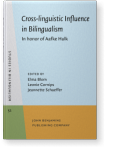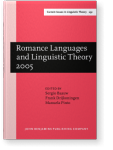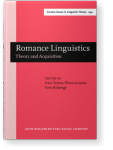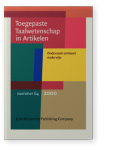Aafke Hulk
List of John Benjamins publications for which Aafke Hulk plays a role.
Book series
Titles
Internal and External Factors in Child Second Language Acquisition
Edited by Aafke Hulk and Theodoros Marinis
Special issue of Linguistic Approaches to Bilingualism 1:3 (2011) v, 139 pp.
Subjects Language acquisition | Multilingualism | Sociolinguistics and Dialectology
The Lexicon–Syntax Interface in Second Language Acquisition
Edited by Roeland van Hout, Aafke Hulk, Folkert Kuiken and Richard J. Towell
[Language Acquisition and Language Disorders, 30] 2003. viii, 234 pp.
Subjects Language acquisition | Semantics | Syntax
2018 The influence of L2 English on L3 French acquisition in bilingual education CLIL and Bilingual Education in the Netherlands, Mearns, Tessa and Rick de Graaff (eds.), pp. 227–245 | Article
In the present paper, we compare L2 English influence on French third language acquisition (L3A) in first-year and third-year bilingual stream secondary school students and in third-year mainstream secondary school students by means of a gap-filling task. We found that the influence of L2… read more
2018 The role of L2 exposure in L3A: A comparative study between third and fourth year secondary school students in the Netherlands Romance Languages and Linguistic Theory 13: Selected papers from ‘Going Romance’ 29, Nijmegen, Berns, Janine, Haike Jacobs and Dominique Nouveau (eds.), pp. 279–296 | Chapter
In this study, we test the L2 Status Factor hypothesis (Bardel & Falk, 2007, 2012), which claims that the L2 is the preferred background language over the L1 in L3 acquisition (henceforth L3A), and we investigate the effect of L2 English exposure on the role of the L1 and the L2 in L3A. We examine… read more
2017 Note on cross-linguistic influence: Back to “MULK” Cross-linguistic Influence in Bilingualism: In honor of Aafke Hulk, Blom, Elma, Leonie Cornips and Jeannette Schaeffer (eds.), pp. 15–24 | Chapter
2017 Chapter 4. Knowledge of mood in internal and external interface contexts in Spanish heritage speakers in the Netherlands Multidisciplinary Approaches to Bilingualism in the Hispanic and Lusophone World, Bellamy, Kate, Michael W. Child, Paz González, Antje Muntendam and M. Carmen Parafita Couto (eds.), pp. 67–94 | Chapter
This study investigates Spanish heritage speakers in the Netherlands on their judgments of Spanish mood in a syntactic context and in two interface contexts: the internal interface between syntax and semantics and the external interface between syntax and pragmatics. The strong version of the… read more
2016 The influence of L2 English and immersion education on L3 French in the Netherlands Linguistics in the Netherlands 2016, Audring, Jenny and Sander Lestrade (eds.), pp. 152–165 | Article
In this paper, we test the L2 Status Factor (Bardel & Falk, 2007) by examining to what extent Dutch secondary school students (13–15 years) prefer L2 English over L1 Dutch in L3 French acquisition, and we study the influence of L2 education by comparing an English immersion curriculum vs. a… read more
2014 Gender agreement in interface contexts in the oral production of heritage speakers of Spanish in the Netherlands Linguistics in the Netherlands 2014, Auer, Anita and Björn Köhnlein (eds.), pp. 93–106 | Article
In this paper we present an analysis of Spanish heritage speakers’ oral production of gender agreement outside the DP as an innovative source of support for the Interface Hypothesis (Sorace & Filiaci 2006). We demonstrate that, besides commonly known factors such as the gender, animacy and… read more
2013 Late language acquisition and identity construction: Variation in use of the Dutch definite determiners de and het Language Variation - European Perspectives IV: Selected papers from the Sixth International Conference on Language Variation in Europe (ICLaVE 6), Freiburg, June 2011, Auer, Peter, Javier Caro Reina and Göz Kaufmann (eds.), pp. 57–68 | Article
Aacquisition of the grammatical gender of the Dutch definite common determiner de and neuter het is a long-lasting process since monolingual children do not acquire a target grammar with respect to the use of het until the age of six. Before that age, they overuse de. Bilingual child acquirers from… read more
2013 L1 acquisition of noun ellipsis in French and in Dutch: Consequences for linguistic theory Romance Languages and Linguistic Theory 2011: Selected papers from 'Going Romance' Utrecht 2011, Baauw, Sergio, Frank Drijkoningen, Luisa Meroni and Manuela Pinto (eds.), pp. 249–266 | Article
In the literature several theoretical analyses of nominal ellipsis of various languages have been proposed. In this exploratory and comparative study the L1 French and Dutch acquisition of noun ellipsis is analyzed. The L1 data suggest that a theoretical analysis of the licensing mechanisms of… read more
2012
Dutch nouns are divided into two groups according to grammatical gender which is, among others, marked on the definite determiner: common nouns take the definite determiner de and neuter nouns take the definite determiner het. This study is unique in systematically investigating the acquisition of… read more
2011
2008 Misrepresentation of Dutch neuter gender in older bilingual children? Current Trends in Child Second Language Acquisition: A generative perspective, Haznedar, Belma and Elena Gavruseva (eds.), pp. 83–96 | Article
Previous research revealed that monolingual children between 11- and 13-yearold show a target-like production with respect to gender assignment of definite determiners whereas this is not the case for bilingual children who massively overgeneralize de. In order to further investigate this… read more
2007 Deviance in early child bilingualism Romance Linguistics 2006: Selected papers from the 36th Linguistic Symposium on Romance Languages (LSRL), New Brunswick, March-April 2006, Camacho, José, Nydia Flores-Ferrán, Liliana Sánchez, Viviane Déprez and María José Cabrera (eds.), pp. 183–204 | Article
2007 Cross-linguistic influence in bilingual children: The case of dislocation Romance Languages and Linguistic Theory 2005: Selected papers from ‘Going Romance’, Utrecht, 8–10 December 2005, Baauw, Sergio, Frank Drijkoningen and Manuela Pinto (eds.), pp. 229–258 | Article
Serratrice et al. (2004) propose to extend Hulk & Müller’s (2000, 2001) hypothesis on cross-linguistic influence in early child bilingualism to include cases of influence after instantiation of the C-system (i.e. at a later stage of development). In the present article, we explore whether such an… read more
2006 External and internal factors in billingual and bidialectal language development: Grammatical gender of the Dutch definite determiner L2 Acquisition and Creole Genesis: Dialogues, Lefebvre, Claire, Lydia White and Christine Jourdan (eds.), pp. 355–377 | Article
2006 Neuter gender and interface vulnerability in child L2/2L1 Dutch Paths of Development in L1 and L2 acquisition: In honor of Bonnie D. Schwartz, Unsworth, Sharon, Teresa Parodi, Antonella Sorace and Martha Young-Scholten (eds.), pp. 107–134 | Article
2006 Between 2L1- and child L2 acquisition: An experimental study of bilingual Dutch Interfaces in Multilingualism: Acquisition and representation, Lleó, Conxita (ed.), pp. 115–137 | Article
2005 Daar Zijn ze Weer, de Dieren: Dislocatiestructuren bij (een- en) tweetalige kinderen Meertaligheid zonder meer, pp. 59–69 | Article
In this paper, we investigate the development of dislocation structures in three French-Dutch bilingual children. Dislocations are a syntactic means of marking the element that is the topic of an utterance. As such, they constitute the interface between syntax and pragmatics, a domain that has been… read more
2004 The acquisition of the French DP in a bilingual context The Acquisition of French in Different Contexts: Focus on functional categories, Prévost, Philippe and Johanne Paradis (eds.), pp. 243–274 | Article
2003 10. The interface: Concluding remarks The Lexicon–Syntax Interface in Second Language Acquisition, Hout, Roeland van, Aafke Hulk, Folkert Kuiken and Richard J. Towell (eds.), pp. 219–226 | Chapter
2003 Merging scope particles: Word order variation and the acquisition of aussi and ook in a bilingual context Information Structure and the Dynamics of Language Acquisition, Dimroth, Christine and Marianne Starren (eds.), pp. 211–234 | Article
2003 Acquiring the Syntax of beaucoup at a distance as a Bilingual Child: An Experimental Study Romance Linguistics: Theory and Acquisition, Pérez-Leroux, Ana Teresa and Yves Roberge (eds.), pp. 299–316 | Article
2000 Non-Selective Access and Activation in Child Bilingualism: The syntax Cross-Linguistic Structures in Simultaneous Bilingualism, Döpke, Susanne (ed.), pp. 57–78 | Article
2000 Ik Deux Jambes: Variatie in de Taal van Tweetalige Kinderen Onderzoek ontmoet onderwijs, pp. 137–144 | Article
In this paper, we argue that variation in child bilingualism has received too little attention. The literature on monolingual acquisition shows that children vary in the routes they follow towards linguistic proficiency: children have preferences for the acquisition of certain word classes (Nelson… read more
1999 Conflictual Agreement in Romance Nominals Formal Perspectives on Romance Linguistics: Selected papers from the 28th Linguistic Symposium on Romance Languages (LSRL XXVIII), University Park, 16–19 April 1998, Authier, Jean-Marc, Barbara E. Bullock and Lisa A. Reed (eds.), pp. 179–196 | Article
1998 Affected Objects in Heerlen Dutch and Romance Languages in Contrast 1:2, pp. 191–210 | Article
In this paper we show that the well known definition of affected object — as an object that is somehow altered or modified by the action expressed by the verb — is problematic with respect to middle formation, which has been claimed in the literature to be possible only with affected objects. The… read more
1998 Tweede-Taalverwerving in Discussie Toegepaste taalwetenschap in discussie, pp. 77–85 | Article
Universal aspects of L2 learner varieties are currently being discussed with respect to the issue of the 'L2-initial state'. Minimal Tree (Vainikka & Young-Scholten, 1996), Full Transfer/ Full Access (Schwartz & Sprouse, 1996) and Valueless Features approach (Eubank, 1996) are three approaches that… read more
1997 Negation as a Reflex of Clause Structure Negation and Polarity: Syntax and semantics. Selected papers from the colloquium Negation: Syntax and Semantics. Ottawa, 11–13 May 1995, Forget, Danielle, Paul Hirschbühler, France Martineau and María Luisa Rivero (eds.), pp. 183–208 | Article
1996 How "greedy" is the French imperative? Linguistics in the Netherlands 1996, Cremers, Crit and Marcel den Dikken (eds.), pp. 97–108 | Article
1996 Language Mixing in a French-Dutch Bilingual Child EUROSLA 6: A selection of papers, pp. 89–101 | Article
Child bilingualism has been a domain of growing interest in the last few years. A central question in research concerns the differentiation of the two languages in the developmen-tal process: do children develop two separate language systems from the very beginning or do they start with a combined… read more
1992 'Something funny' in French Linguistics in the Netherlands 1992, Bok-Bennema, Reineke and Roeland van Hout (eds.), pp. 87–100 | Article
1988 Review of Vergnaud (1985): Dépendances et niveaux de représentation en syntaxe Studies in Language 12:1, pp. 179–185 | Review

































